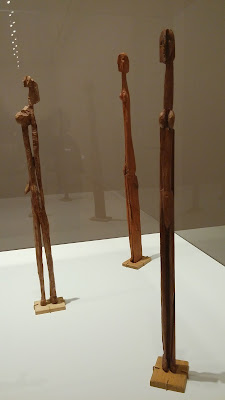 "Picasso Sculpture" at the Museum of Modern Art is a large and well organized show. Pablo Picasso's sculptures are viewed, if you proceed from entrance to exit in an obedient fashion, in chronological order. Work created in the same studio is grouped in each gallery along the way, and Picasso had many studios over the course of his long life. The exhibit has 11 galleries - and a lot of people, even on a cold January weekday, wandering through them.
"Picasso Sculpture" at the Museum of Modern Art is a large and well organized show. Pablo Picasso's sculptures are viewed, if you proceed from entrance to exit in an obedient fashion, in chronological order. Work created in the same studio is grouped in each gallery along the way, and Picasso had many studios over the course of his long life. The exhibit has 11 galleries - and a lot of people, even on a cold January weekday, wandering through them.
I will take the MOMA's careful organization and muss it all up.
Starting with the charming, small painted bronze, "Woman Reading," from the early 1950's, made half a century after he first began to make sculpture. It somehow conveys a relaxed and engaged woman despite a body that is chunky piece of wood, an arm that is a machine bolt, and other scavenged ordinary objects making up her body parts. Picasso was a dumpster diver, or the equivalent in his day, an early adopter in the art world of trash art. He was recycling and repurposing the detritus of his world and recasting it in bronze.
Let's look at some other women. Here is a rather humorous, "Woman in the Garden," from 1929-30. Whatever she is doing, she looks like she is having a marvelous time, her hair blowing sideways in the wind. She is a tall one, about life size, all of welded metal.

This the largest woman. She holds a vase. In my photo the vase is covering up the nice museum goer in the back. The sculpture woman has an exceedingly long arm with at least 3 bends in it and a very small face in her bulbous head. I find this a very amusing and audacious sculpture.
 |
| the very small face |
So primitively executed, little stick arms wired wrapped to the body, this looks like a homemade doll by an urchin living in a shack by the railroad tracks.
Well, it was made during the Great Depression, though I don't think Picasso let that stop him. He'd been poor before. By 1930, Picasso was a famous artist, though a degenerate, Hitler claimed. He could have used real "artist" materials. Yet he chose these bits of salvaged wood and string and wire.

There's a tiny face on this "Woman with a Baby Carriage," too. The two owl eyes are not eyes, but breasts hovering high above her shoulders. The face is way up at the top of the periscope-like neck.
And while we're here, this is the baby. An ugly baby, someone I know would say, "Put a bonnet on it!"
Our last woman, this is one of several massive stone heads that, I am guessing, were inspired by his blonde wife, the languorous Marie-Therese, they look like her with her curves and roundness.
Oddly enough, they were made in the same decade as the tall, thin figures and the wooden doll-like figure. Picasso was really ALL OVER THE PLACE.
This flies in the face of the know-it-alls in the art world who say you must specialize and have a style that is identifiable. Picasso himself was not so inclined.
More on the Picasso show later...







El,
ReplyDeleteThe photos are fabulous. I must admit, when I looked at the first shot of the woman with the baby carriage, I thought how "odd"...Picasso had a woman with a SNOW BLOWER!?!?!?! Must be my mindset after the yesterday's Monster Storm!